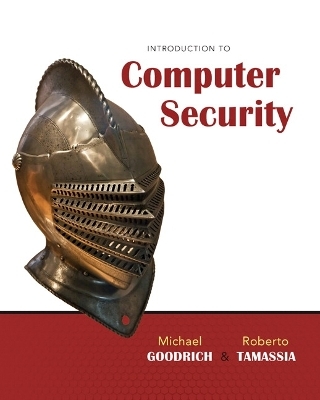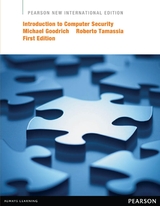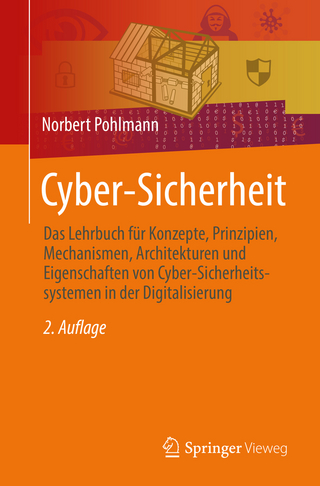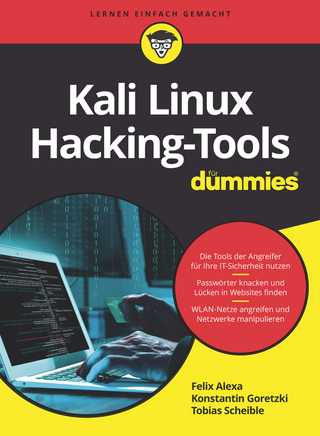
Introduction to Computer Security
Pearson (Verlag)
978-0-321-51294-9 (ISBN)
- Titel erscheint in neuer Auflage
- Artikel merken
Unlike most other computer security textbooks available today, Introduction to Computer Security, 1e does NOT focus on the mathematical and computational foundations of security, and it does not assume an extensive background in computer science. Instead it looks at the systems, technology, management, and policy side of security, and offers students fundamental security concepts and a working knowledge of threats and countermeasures with “just-enough” background in computer science. The result is a presentation of the material that is accessible to students of all levels.
Professors Goodrich and Tamassia are well-recognized researchers in computer security, algorithms and data structures, having published many papers on these subjects, with applications to computer security, cryptography, cloud computing, information visualization, and geometric computing. They have served as principal investigators in several joint projects sponsored by the National Science Foundation, the Army Research Office, and the Defense Advanced Research Projects Agency. They are also active in educational technology research, and they have published several books, including a widely adopted textbook on data structures and algorithms. Michael Goodrich received his Ph.D. in computer science from Purdue University. He is currently a Chancellor’s Professor in the Department of Computer Science at University of California, Irvine. Previously, he was a professor at Johns Hopkins University. He is an editor for the Journal of Computer and Systems Sciences and the Journal of Graph Algorithms and Applications. He is a Fulbright Scholar, a Distinguished Scientist of the Association for Computing Machinery (ACM), and a Fellow of the American Association for the Advancement of Science (AAAS), the ACM, and the Institute of Electrical and Electronics Engineers (IEEE). Roberto Tamassia received his Ph.D. in electrical and computer engineering from the University of Illinois at Urbana-Champaign. He is currently the Plastech Professor of Computer Science and the chair of the Department of Computer Science at Brown University. He is a founder and editor-in-chief for the Journal of Graph Algorithms and Applications. He previously served on the editorial board of Computational Geometry: Theory and Applications and IEEE Transactions on Computers. He is a Fellow of the Institute of Electrical and Electronics Engineers (IEEE). In addition to their research accomplishments, the authors also have extensive experience in the classroom. For example, Goodrich has taught data structures and algorithms courses, including Data Structures as a freshman-sophomore level course, Applied Cryptography as a sophomore- junior level course, and Internet Algorithmics as an upper level course. He has earned several teaching awards in this capacity. Tamassia has taught Data Structures and Algorithms as an introductory freshman-level course and Computational Geometry as an advanced graduate course. Over the last several years he has developed "Introduction to Computer Systems Security," a new computer security course aimed at sophomores. His teaching of this course since 2006 has helped to shape the vision and topics of this book. One thing that has set his teaching style apart is his effective use of interactive hypermedia presentations integrated with the web.
1 Introduction 1
1.1 Fundamental Concepts . . . . . . . . . . . . . . . . . . . . . 2
1.2 Access Control Models . . . . . . . . . . . . . . . . . . . . . 19
1.3 Cryptographic Concepts . . . . . . . . . . . . . . . . . . . . . 25
1.4 Implementation and Usability Issues . . . . . . . . . . . . . . 39
1.5 Exercises . . . . . . . . . . . . . . . . . . . . . . . . . . . . . 46
2 Physical Security 55
2.1 Physical Protections and Attacks . . . . . . . . . . . . . . . . 56
2.2 Locks and Safes . . . . . . . . . . . . . . . . . . . . . . . . . 57
2.3 Authentication Technologies . . . . . . . . . . . . . . . . . . . 71
2.4 Direct Attacks Against Computers . . . . . . . . . . . . . . . 88
2.5 Special-Purpose Machines . . . . . . . . . . . . . . . . . . . 99
2.6 Physical Intrusion Detection . . . . . . . . . . . . . . . . . . . 13
2.7 Exercises . . . . . . . . . . . . . . . . . . . . . . . . . . . . . 106
3 Operating Systems Security 113
3.1 Operating Systems Concepts . . . . . . . . . . . . . . . . . . 114
3.2 Process Security . . . . . . . . . . . . . . . . . . . . . . . . . 130
3.3 Memory and Filesystem Security . . . . . . . . . . . . . . . . 136
3.4 Application Program Security . . . . . . . . . . . . . . . . . . 149
3.5 Exercises . . . . . . . . . . . . . . . . . . . . . . . . . . . . . 166
4 Malware 173
4.1 Insider Attacks . . . . . . . . . . . . . . . . . . . . . . . . . . 174
4.2 Computer Viruses . . . . . . . . . . . . . . . . . . . . . . . . 181
4.3 Malware Attacks . . . . . . . . . . . . . . . . . . . . . . . . . 188
4.4 Privacy-Invasive Software . . . . . . . . . . . . . . . . . . . . 202
4.5 Countermeasures . . . . . . . . . . . . . . . . . . . . . . . . 208
4.6 Exercises . . . . . . . . . . . . . . . . . . . . . . . . . . . . . 215
5 Network Security I 221
5.1 Network Security Concepts . . . . . . . . . . . . . . . . . . . 222
5.2 The Link Layer . . . . . . . . . . . . . . . . . . . . . . . . . . 229
5.3 The Network Layer . . . . . . . . . . . . . . . . . . . . . . . . 236
5.4 The Transport Layer . . . . . . . . . . . . . . . . . . . . . . . 246
5.5 Denial-of-Service Attacks . . . . . . . . . . . . . . . . . . . . 256
5.6 Exercises . . . . . . . . . . . . . . . . . . . . . . . . . . . . . 264
6 Network Security II 269
6.1 The Application Layer and DNS . . . . . . . . . . . . . . . . . 270
6.2 Firewalls . . . . . . . . . . . . . . . . . . . . . . . . . . . . . . 287
6.3 Tunneling . . . . . . . . . . . . . . . . . . . . . . . . . . . . . 292
6.4 Intrusion Detection . . . . . . . . . . . . . . . . . . . . . . . . 299
6.5 Wireless Networking . . . . . . . . . . . . . . . . . . . . . . . 313
6.6 Exercises . . . . . . . . . . . . . . . . . . . . . . . . . . . . . 322
7 Web Security 327
7.1 The World Wide Web . . . . . . . . . . . . . . . . . . . . . . 328
7.2 Attacks on Clients . . . . . . . . . . . . . . . . . . . . . . . . 347
7.3 Attacks on Servers . . . . . . . . . . . . . . . . . . . . . . . . 368
7.4 Exercises . . . . . . . . . . . . . . . . . . . . . . . . . . . . . 382
8 Cryptography 387
8.1 Symmetric Cryptography . . . . . . . . . . . . . . . . . . . . 388
8.2 Public-Key Cryptography . . . . . . . . . . . . . . . . . . . . . 406
8.3 Cryptographic Hash Functions . . . . . . . . . . . . . . . . . 417
8.4 Digital Signatures . . . . . . . . . . . . . . . . . . . . . . . . . 421
8.5 Details on AES and RSA . . . . . . . . . . . . . . . . . . . . 425
8.6 Exercises . . . . . . . . . . . . . . . . . . . . . . . . . . . . . 439
9 Security Models and Practice 445
9.1 Policy, Models, and Trust . . . . . . . . . . . . . . . . . . . . . 446
9.2 Access Control Models . . . . . . . . . . . . . . . . . . . . . 450
9.3 Security Standards and Evaluation . . . . . . . . . . . . . . . 460
9.4 Software Vulnerability Assessment . . . . . . . . . . . . . . . 464
9.5 Administration and Auditing . . . . . . . . . . . . . . . . . . . 470
9.6 Kerberos . . . . . . . . . . . . . . . . . . . . . . . . . . . . . 475
9.7 Secure Storage . . . . . . . . . . . . . . . . . . . . . . . . . . 479
9.8 Exercises . . . . . . . . . . . . . . . . . . . . . . . . . . . . . 484
10 Distributed-Applications Security 487
10.1 Database Security . . . . . . . . . . . . . . . . . . . . . . . . 488
10.2 Email Security . . . . . . . . . . . . . . . . . . . . . . . . . . 500
10.3 Payment Systems and Auctions . . . . . . . . . . . . . . . . . 513
10.4 Digital Rights Management . . . . . . . . . . . . . . . . . . . 519
10.5 Social Networking . . . . . . . . . . . . . . . . . . . . . . . . 528
10.6 Voting Systems . . . . . . . . . . . . . . . . . . . . . . . . . . 531
10.7 Exercises . . . . . . . . . . . . . . . . . . . . . . . . . . . . . 535
| Erscheint lt. Verlag | 10.2.2011 |
|---|---|
| Sprache | englisch |
| Maße | 10 x 10 mm |
| Gewicht | 1310 g |
| Themenwelt | Informatik ► Netzwerke ► Sicherheit / Firewall |
| ISBN-10 | 0-321-51294-4 / 0321512944 |
| ISBN-13 | 978-0-321-51294-9 / 9780321512949 |
| Zustand | Neuware |
| Haben Sie eine Frage zum Produkt? |
aus dem Bereich



